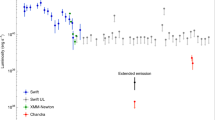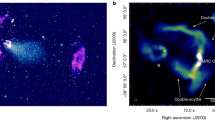Abstract
Radio pulsars scintillate because their emission travels through the ionized interstellar medium along multiple paths, which interfere with each other. It has long been realized that, independent of their nature, the regions responsible for the scintillation could be used as ‘interstellar lenses’ to localize pulsar emission regions1,2. Most such lenses, however, resolve emission components only marginally, limiting results to statistical inferences and detections of small positional shifts3,4,5. As lenses situated close to their source offer better resolution, it should be easier to resolve emission regions of pulsars located in high-density environments such as supernova remnants6 or binaries in which the pulsar’s companion has an ionized outflow. Here we report observations of extreme plasma lensing in the ‘black widow’ pulsar, B1957+20, near the phase in its 9.2-hour orbit at which its emission is eclipsed by its companion’s outflow7,8,9. During the lensing events, the observed radio flux is enhanced by factors of up to 70–80 at specific frequencies. The strongest events clearly resolve the emission regions: they affect the narrow main pulse and parts of the wider interpulse differently. We show that the events arise naturally from density fluctuations in the outer regions of the outflow, and we infer a resolution of our lenses that is comparable to the pulsar’s radius, about 10 kilometres. Furthermore, the distinct frequency structures imparted by the lensing are reminiscent of what is observed for the repeating fast radio burst FRB 121102, providing observational support for the idea that this source is observed through, and thus at times strongly magnified by, plasma lenses10.
This is a preview of subscription content, access via your institution
Access options
Access Nature and 54 other Nature Portfolio journals
Get Nature+, our best-value online-access subscription
$29.99 / 30 days
cancel any time
Subscribe to this journal
Receive 51 print issues and online access
$199.00 per year
only $3.90 per issue
Buy this article
- Purchase on Springer Link
- Instant access to full article PDF
Prices may be subject to local taxes which are calculated during checkout



Similar content being viewed by others
References
Lovelace, R. V. E. Theory and Analysis of Interplanetary Scintillations. PhD thesis, Cornell Univ. (1970).
Backer, D. C. Interstellar scattering of pulsar radiation. I: Scintillation. Astron. Astrophys. 43, 395–404 (1975).
Gwinn, C. R. et al. Size of the Vela pulsar’s emission region at 18 cm wavelength. Astrophys. J. 758, 7 (2012).
Johnson, M. D., Gwinn, C. R. & Demorest, P. Constraining the Vela pulsar’s radio emission region using Nyquist-limited scintillation statistics. Astrophys. J. 758, 8 (2012).
Pen, U.-L., Macquart, J.-P., Deller, A. T. & Brisken, W. 50 picoarcsec astrometry of pulsar emission. Mon. Not. R. Astron. Soc. 440, L36–L40 (2014).
Main, R. et al. Mapping the emission location of the Crab pulsar’s giant pulses. Preprint at https://arxiv.org/abs/1709.09179 (2017).
Fruchter, A. S., Stinebring, D. R. & Taylor, J. H. A millisecond pulsar in an eclipsing binary. Nature 333, 237–239 (1988).
Fruchter, A. S. et al. The eclipsing millisecond pulsar PSR 1957 + 20. Astrophys. J. 351, 642–650 (1990).
Ryba, M. F. & Taylor, J. H. High-precision timing of millisecond pulsars. II: Astrometry, orbital evolution, and eclipses of PSR 1957 + 20. Astrophys. J. 380, 557–563 (1991).
Cordes, J. M. et al. Lensing of fast radio bursts by plasma structures in host galaxies. Astrophys. J. 842, 35 (2017).
Main, R., van Kerkwijk, M., Pen, U.-L., Mahajan, N. & Vanderlinde, K. Descattering of giant pulses in PSR B1957+20. Astrophys. J. Lett. 840, L15 (2017).
Bilous, A. V., Ransom, S. M. & Nice, D. J. in American Institute of Physics Conf. Ser. Vol. 1357 (eds Burgay, M. et al.) 140–141 (2011).
Van Kerkwijk, M. H., Breton, R. P. & Kulkarni, S. R. Evidence for a massive neutron star from a radial-velocity study of the companion to the black-widow pulsar PSR B1957+20. Astrophys. J. 728, 95 (2011).
Ginzburg, V. L. & Zhelezniakov, V. V. On the pulsar emission mechanisms. Annu. Rev. Astron. Astrophys. 13, 511–535 (1975).
Thompson, C., Blandford, R. D., Evans, C. R. & Phinney, E. S. Physical processes in eclipsing pulsars: eclipse mechanisms and diagnostics. Astrophys. J. 422, 304–335 (1994).
Masui, K. et al. Dense magnetized plasma associated with a fast radio burst. Nature 528, 523–525 (2015).
Tendulkar, S. P. et al. The host galaxy and redshift of the repeating fast radio burst FRB 121102. Astrophys. J. Lett. 834, L7 (2017).
Bassa, C. G. et al. FRB 121102 is coincident with a star-forming region in its host galaxy. Astrophys. J. Lett. 843, L8 (2017).
Michilli, D. et al. An extreme magneto-ionic environment associated with the fast radio burst source FRB 121102. Nature 553, 182–185 (2018).
Spitler, L. G. et al. A repeating fast radio burst. Nature 531, 202–205 (2016).
Scholz, P. et al. The repeating fast radio burst FRB 121102: multi-wavelength observations and additional bursts. Astrophys. J. 833, 177 (2016).
Law, C. J. et al. A multi-telescope campaign on FRB 121102: implications for the FRB population. Astrophys. J. 850, 76 (2017).
Born, M. & Wolf, E. Principles of Optics: Electromagnetic Theory of Propagation, Interference and Diffraction of Light (Cambridge Univ. Press, Cambridge, 1999).
Manchester, R. N. & Taylor, J. H. Parameters of 61 pulsars. Astrophys. Lett. 10, 67–70 (1972).
Nye, J. F. Natural Focusing and Fine Structure of Light: Caustics and Wave Dislocations (IOP, London, 1999).
van Paradijs, J. et al. Optical observations of the eclipsing binary radio pulsar PSR1957 + 20. Nature 334, 684–686 (1988).
Reynolds, M. T. et al. The light curve of the companion to PSR B1957+20. Mon. Not. R. Astron. Soc. 379, 1117–1122 (2007).
Acknowledgements
We thank A. Bilous for sharing and discussing her results which motivated this analysis. We thank the rest of our scintillometry group for discussions and support throughout. R.M., M.H.v.K., U.-L.P. and K.V. are funded through NSERC. I-S.Y was supported by a SOSCIP Consortium Postdoctoral Fellowship.
Reviewer information
Nature thanks S. Ransom and J. Hessels for their contribution to the peer review of this work.
Author information
Authors and Affiliations
Contributions
R.M. discovered the magnified pulses; wrote the majority of the manuscript; and created the figures. I-S.Y. developed and wrote the sections on wave-optics formalism in the Methods; M.H.v.K and U.-L.P. guided the analysis and interpretation of the results; M.H.v.K. also helped to write the manuscript and influenced the content and presentation of the figures; F.X.L., V.C. and K.V. quantified the excess dispersion measure associated with the eclipse. N.M. wrote the code used to produce the coherently de-dispersed single pulse profiles used in this analysis, and derived an improved orbital ephemeris relative to which time delays are measured. D.L. worked on criteria to systematically separate giant pulses from pulses magnified by plasma lensing. All authors contributed to the interpretation of results.
Corresponding author
Ethics declarations
Competing interests
The authors declare no competing financial interests.
Additional information
Publisher’s note: Springer Nature remains neutral with regard to jurisdictional claims in published maps and institutional affiliations.
Extended data figures and tables
Extended Data Fig. 1 Shock geometry.
The brown dwarf companion is irradiated by the pulsar wind, causing it to be hotter on the side facing the pulsar26, and inflated, nearly filling its Roche lobe27. Outflowing material is shocked by the pulsar wind, leaving a cometary-like tail of material. This tail is asymmetric because of the companion’s orbital motion, which leads to eclipse egress lasting substantially longer than ingress. The companion and separations are drawn roughly to scale, whereas the pulsar is not: the light cylinder radius of 76 km would be indistinguishable on this figure. The inclination of the system is conservatively constrained to \(5{0}^{\circ } < i < 8{5}^{\circ }\) (ref. 13). vp and vc are the velocities of the pulsar and companion, a is the semi-major axis of the orbit, and Rroche is the Roche lobe of the companion.
Extended Data Fig. 2 Dispersion measure near the radio eclipse.
Shown is the excess dispersion measure relative to the interstellar dispersion, with insets focusing on regions of strong lensing. The excess dispersion is estimated from delays in pulse arrival times (see Methods); at our observing frequency of 330 MHz, ΔDM = 0.001 pc cm−3 corresponds to a delay of 38 μs. The scatter around the curves is intrinsic. During periods of strong lensing, it is at a level of 2.6 × 10−5 pc cm−3, corresponding to variations in delay time of 1 μs.
Extended Data Fig. 3 Pulse profiles and magnification distributions.
a–e, Each row shows pulse profiles for 10-s segments (left, in 128 phase bins), and the corresponding magnification distributions. The segments are taken from: a, a quiescent region, showing a log-normal magnification distribution (repeated using a dotted line in b–e for comparison); b, eclipse ingress, showing some lensing events, reflected in the tail to high magnification; although hard to see, the average flux is reduced to about 70% by absorption in eclipsing material); c, the first post-eclipse lensing period, showing extreme magnifications but little change in average flux; d, in between the two post-eclipse strong lensing periods, showing only weak lensing on relatively long, approximately 100-ms timescales; e, the second post-eclipse period of strong lensing.
Extended Data Fig. 4 Geometry of a lensing region.
An almost edge-on (left) and a face-on (right) view of the lensing geometry. We assume that the source is at a separation from the pulsar equal to the semi-major axis a of the binary system and moves on a trajectory parallel to the lens plane. A source at the focal point (X, Y) will illuminate the entire elliptical lens coherently, leading to strong magnification. In general, the focal point may not be at the centre of the ellipse (although it is likely to be within it), and the source trajectory [xs(t), ys(t)] may not intersect the focal point or the elliptical region.
Rights and permissions
About this article
Cite this article
Main, R., Yang, IS., Chan, V. et al. Pulsar emission amplified and resolved by plasma lensing in an eclipsing binary. Nature 557, 522–525 (2018). https://doi.org/10.1038/s41586-018-0133-z
Received:
Accepted:
Published:
Issue Date:
DOI: https://doi.org/10.1038/s41586-018-0133-z
This article is cited by
-
A link between repeating and non-repeating fast radio bursts through their energy distributions
Nature Astronomy (2024)
-
Scintillation Arc from FRB 20220912A
Science China Physics, Mechanics & Astronomy (2024)
-
An X-ray burst from a magnetar enlightening the mechanism of fast radio bursts
Nature Astronomy (2021)
-
Periodic activity from a fast radio burst source
Nature (2020)
-
A second source of repeating fast radio bursts
Nature (2019)
Comments
By submitting a comment you agree to abide by our Terms and Community Guidelines. If you find something abusive or that does not comply with our terms or guidelines please flag it as inappropriate.



